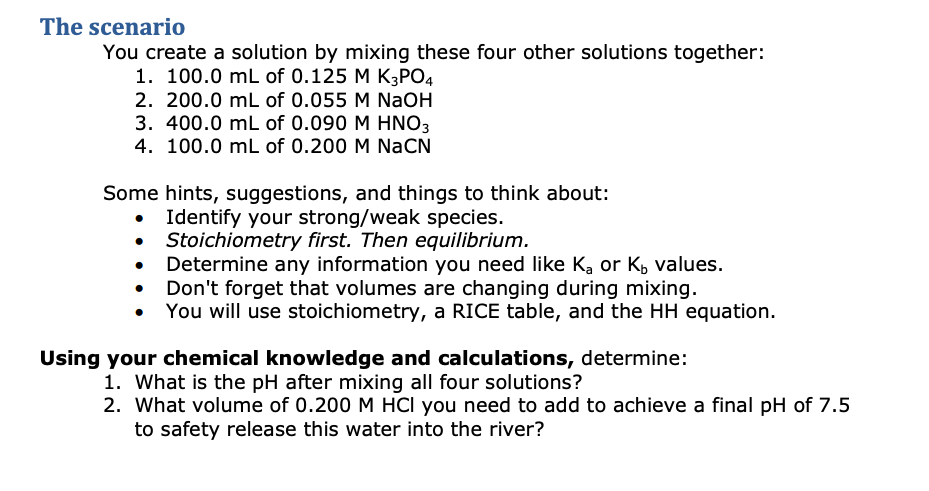

Background We rarely consider the consequences of our waste once it's out of sight. The effects don't just disappear; they persist long afterward. The cadmium, nickel, lithium, and other metals in that battery you tossed in the trash will poison groundwater for decades or centuries. Those are chronic effects that persist over time (centuries or more!). For acids or bases, the effects are acute- they happen very quickly and are more easily observable. This is why we have technicians and engineers at massive water treatment facilities. They are the invisible people that clean up your waste. They remove as much of this chemical garbage as they can. In this scenario you will do a calculation similar to what a water quality technician would do in order to adjust water pH for release into a river. The only difference here is that you we'll use smaller volumes and wildlife won't be poisoned if you mess up. This scenario is unique and requires calculations. You still go through the same analysis process- set up the problem clearly, explain what you are doing and why you are doing it, and arrive at a justifiable answer. You must support your calculations using logic and reasoning. Writing still matters. Evaluation: We look for a complete, detailed setup (+1). We look for clear, chemically relevant explanations of your thinking along the way (+1). We are also looking for at how far you get in the problem. This is not about accuracy, but about demonstrating a solid problem solving process and not giving impossible answers. Two tips to help: 1. You will only get a 1 out of 3 if you turn in math with no writing. Your analysis and reasoning still matters. 2. Everything starts from the relevant reactions. If the reactions are not given, the final grade will be quite low. The scenario You create a solution by mixing these four other solutions together: 1. 100.0 mL of 0.125 M K3PO4 2. 200.0 mL of 0.055 M NaOH 3. 400.0 mL of 0.090 M HNO3 4. 100.0 mL of 0.200 M NaCN Some hints, suggestions, and things to think about: Identify your strong/weak species. Stoichiometry first. Then equilibrium. Determine any information you need like K, or Ko values. Don't forget that volumes are changing during mixing. You will use stoichiometry, a RICE table, and the HH equation. Using your chemical knowledge and calculations, determine: 1. What is the pH after mixing all four solutions? 2. What volume of 0.200 M HCl you need to add to achieve a final pH of 7.5 to safety release this water into the river? Background We rarely consider the consequences of our waste once it's out of sight. The effects don't just disappear; they persist long afterward. The cadmium, nickel, lithium, and other metals in that battery you tossed in the trash will poison groundwater for decades or centuries. Those are chronic effects that persist over time (centuries or more!). For acids or bases, the effects are acute- they happen very quickly and are more easily observable. This is why we have technicians and engineers at massive water treatment facilities. They are the invisible people that clean up your waste. They remove as much of this chemical garbage as they can. In this scenario you will do a calculation similar to what a water quality technician would do in order to adjust water pH for release into a river. The only difference here is that you we'll use smaller volumes and wildlife won't be poisoned if you mess up. This scenario is unique and requires calculations. You still go through the same analysis process- set up the problem clearly, explain what you are doing and why you are doing it, and arrive at a justifiable answer. You must support your calculations using logic and reasoning. Writing still matters. Evaluation: We look for a complete, detailed setup (+1). We look for clear, chemically relevant explanations of your thinking along the way (+1). We are also looking for at how far you get in the problem. This is not about accuracy, but about demonstrating a solid problem solving process and not giving impossible answers. Two tips to help: 1. You will only get a 1 out of 3 if you turn in math with no writing. Your analysis and reasoning still matters. 2. Everything starts from the relevant reactions. If the reactions are not given, the final grade will be quite low. The scenario You create a solution by mixing these four other solutions together: 1. 100.0 mL of 0.125 M K3PO4 2. 200.0 mL of 0.055 M NaOH 3. 400.0 mL of 0.090 M HNO3 4. 100.0 mL of 0.200 M NaCN Some hints, suggestions, and things to think about: Identify your strong/weak species. Stoichiometry first. Then equilibrium. Determine any information you need like K, or Ko values. Don't forget that volumes are changing during mixing. You will use stoichiometry, a RICE table, and the HH equation. Using your chemical knowledge and calculations, determine: 1. What is the pH after mixing all four solutions? 2. What volume of 0.200 M HCl you need to add to achieve a final pH of 7.5 to safety release this water into the river








